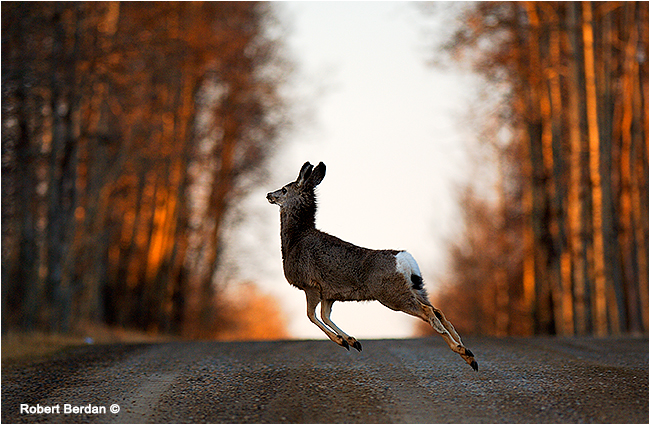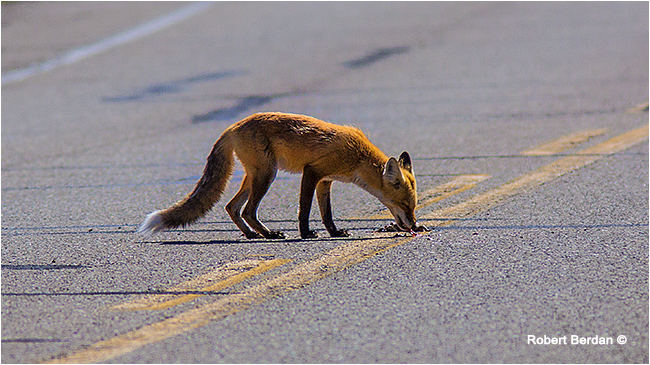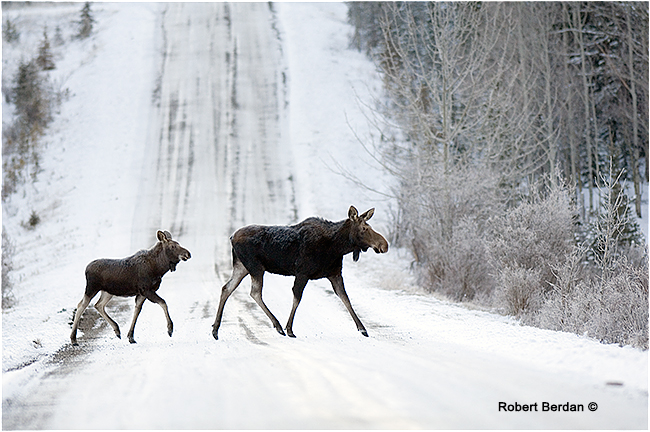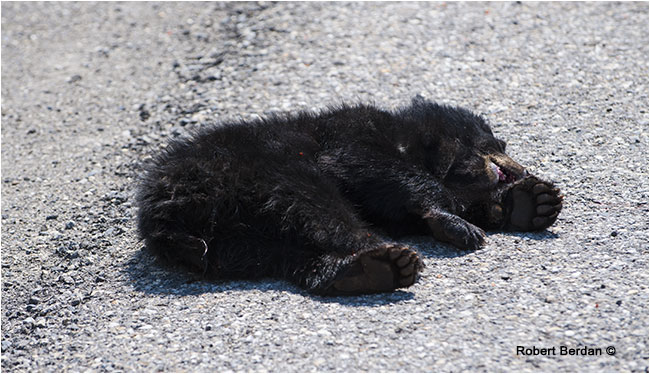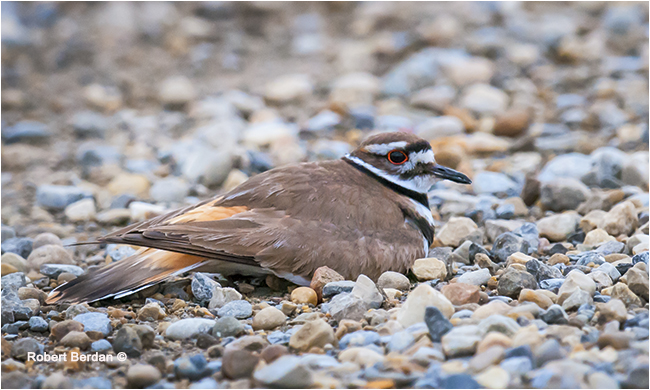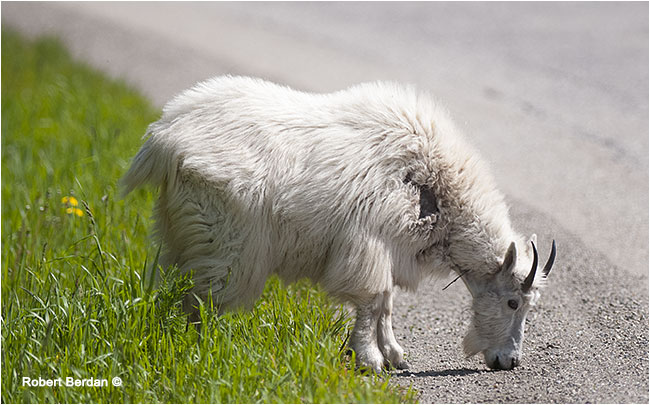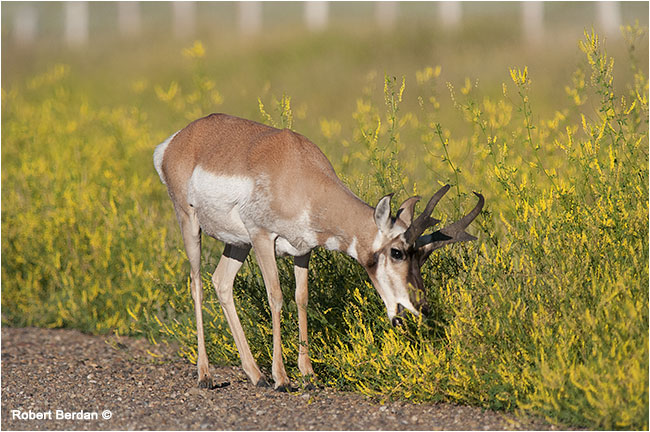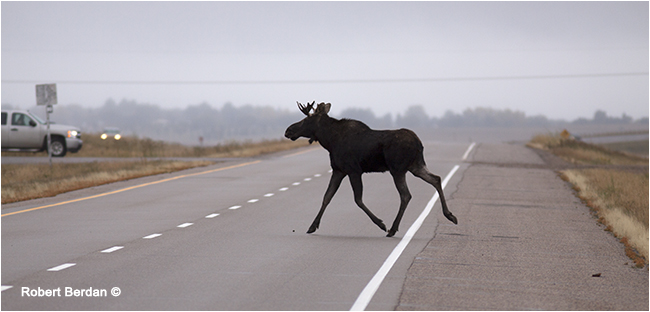
Roadkill - How to Avoid Hitting Wild Animals with Your Vehicle
by Dr. Robert Berdan
October 28, 2014
Moose crossing the highway in Kananaskis - taken with a 70-200 mm lens.
Every year in Canada thousands of animals are hit by vehicles on the road resulting in injury and death to people and the animals. Roadkill is an animal or animals that have been struck and killed by motor vehicles. I have run over small animals such as ground squirrels, rabbits and even hit a deer once while driving home from Cochrane. When I hit the deer I was driving in the dark, there were two lanes and oncoming car lights made if difficult to see anything on either the side of the road. In an instant a deer bounced off my front hood and scared the daylights out of me. Lucky for me I was driving about 20 km below the speed limit. I was out that evening in search of deer to photograph and I found plenty so I was driving extra cautious. Wildlife photographers are often out shooting in the early and late hours of the day when wildlife are near the road.
After hitting the deer I pulled over to check the damage to my jeep and with the hood blocking my view there was no way I could drive on the highway. Thankfully my camera gear was safely stowed in my camera bag. Steam poured out of my radiator and my steering was damaged but I was OK - just shook up. I drove on the side of the highway at 10 km\hr to the Bearspaw gas station a kilometre away and called a tow truck. I also called the RCMP (Royal Canadian Mounted Police) and reported the collision. It took several hours for the tow truck to arrive and the cost to repair my Jeep was over $10,000 - thankfully the cost was covered by insurance. Before the shop would repair my jeep I had to report the accident at a local police station and get a special slip. Hitting an animal can be a scary experience. In this article I describe some things you can do to reduce that possibility and I describe what to do if you hit an animal.
Generally when I am travelling to new areas where wildlife may be abundant I limit my driving in the dark to about an hour before sunrise to an hour after to reduce the risk of collisions. When it is dark, I use my high beams when there is no oncoming traffic. I also drive slower. If the road or weather conditions are poor I slow down even more. In Banff National Park there is a mandatory seasonal overnight travel restriction on some roads (Bow valley Parkway). The speed limit along this side road is 60 km though many vehicles exceed the speed limit. I have suggested to Parks staff that they set up several camera traps along the route which might slow down the traffic and become a source of revenue for the parks. I was told they could not do this. Along this stretch of highway are wolves, bears, elk, deer, and coyotes that are killed regularly. Once in a while I see signs posted to slow down in areas where wolves are frequently seen. I would like to see the speed limit reduced on this road to 30 km and the road open an hour before sunrise to an hour after. The parks could also do more to educate people about speeding where wildlife are abundant - those that aren't willing to slow down should have their park passes revoked after a certain number of infractions. Many visitors to the parks want to see wildlife, the problem is getting them to drive more slowly. Those in a hurry can take the TansCanada highway though even there they can hit animals as it's not completely fenced in nor should it be.
Red Fox feeing on roadkill (squirrel) in Waterton National Park.
Starting March 1, 2014, Parks Canada will begin a mandatory seasonal overnight travel restriction on the Bow Valley Parkway. To ensure the area remains a high quality home for wildlife, from March 1st to June 25th, travel by vehicle, bicycle, or foot is not permitted between 8 p.m. and 8 a.m. on the 17 kilometre section of the parkway between the Trans-Canada Highway/Bow Valley Parkway interchange and Johnston Canyon Campground.
What can you do to reduce collisions with wild animals?
- Drive with extra care where animals are abundant
- Watch for warning signs e.g. moose crossing
- Reduce your speed
- Be mentally prepared and scan both sides of the road
- Use your high beams in the dark so long as there are no oncoming vehicles
- Watch for flickering car head lights ahead which might signal there is an animal on the road
- Watch for roadside reflectors that appear and disappear that might indicate an animal crossing between them
- Pay equal attention to both sides of the road
- If possible avoid driving in certain areas at night where deer, bison and moose are abundant
- If driving to a new area research the roadways where you might encounter animals like bison (see links below)
- If you encounter animals on the road - Honk your horn in a series of bursts this may scare off some animals
Pay attention to warning signs along the road.
Bison are common on highways north of Fort Providence, NT and very difficult to see in the dark.
Moose crossing - Grande Valley Rd, north of Cochrane, AB .
Moose on country road north of Calgary. AB Moose are common north of Calgary and in Kananaskis Provincial Park.
Along some of the highways in Newfoundland are special fences that detect if moose or other animals cross the highway. When an animal breaks the beam running from one pole to another it activates flashing lights.
If a collision is inevitable what's the best thing to do?
- If its a very big animal like a moose or bison, try to swerve and miss it
- If its a smaller animal e.g. coyote, squirrel - try to brake
- Wear your seat-belts at all times
- Honk your horn or flash your lights to scare animals off the road. This may scare a deer, but does not usually work for moose or bison.
Do not take unsafe evasive actions. Serious accidents can occur when drivers lose control of their vehicles trying to avoid an animal. Always reduce your speed in signed areas. Driving at a slower speed may mean it is not necessary to swerve at all. Swerving can take you into the path of an oncoming vehicle or into the ditch. If a deer is in your way, consider using your brakes, not your wheel according to experts.
Mule deer crossing highway in Bearspaw north of Calgary.
If you see a deer on the side of the road like this one, slow down - they sometimes will dart in front of your car, other times they will turn around and head back where they came from. I had one deer run along side me in the ditch and then suddenly dart in front to try and cross the highway. Their behaviour can be unpredictable.
Dead baby black bear killed along the highway in Kananaskis. The mother crossed the road and the two young bears
followed and were hit by a car.
Volunteers stop and try to help the 2nd baby black bear. The mother ran into the woods. The folks did not want
me taking pictures, I grabbed a couple of quick photos and left as I knew I could use them one day to perhaps
educate others.
If you have to choose between swerving or striking a moose, consider swerving. A collision with a moose, which can weigh up to 500 kgs (1200 lbs), carries a significant risk of injury or death to motorists and passengers. If a crash with a moose is inevitable, crouch as low as possible in your seat, or under the dash, as a moose's body usually ends up crushing the roof of a car completely flat (ref http://www.bisonandroads.com/hints.htm).
Bison on the road in Elk Island National Park, AB
Blue ghost moose - I photographed these moose hand held at 2 seconds exposure in Kananaskis about 5 am, It was very dark out, but we could still see several moose crossing in front of our vehicle.
What should drivers do if they hit an animal with their vehicle
- Pull off the road.
- Turn on hazard lights.
- Illuminate the animal with your head lights.
- You may choose to carefully approach the animal to determine if it is dead or injured.
- If it is injured, back off. A wounded animal can be very dangerous. You are not required to put an injured animal out of its misery.
Injured animals are very dangerous.
This appears to be a poached deer - the head was missing.
Elk crossing in front of vehicle on the Bow Valley Parkway.
Only remove the animal if it is safe to do so, and you are physically capable of doing so.
- Inspect your vehicle to see if it safe to continue driving.
- Call the RCMP if there is damage over $1000 or any human injuries.
- Call the Conservation Officer Service if there is a dead or injured animal to report.
In BC - 1.877.952.7277
In AB - 1.800 642.3800
- In a National Park, like Jasper, Banff, Kootenay etc., contact the Park Wardens. Even if your vehicle is not damaged, reporting the exact location helps wardens monitor injured animals and recover dead ones. Quick removal prevents other animals from being attracted to the highway.
- Report vehicle damage to your insurance company.
Collisions with smaller animals such as ground squirrels, birds and reptiles may not harm the passengers or vehicle, but we should try to avoid such collisions where ever possible. In some areas of Alberta some drivers will intentionally try to run over rattle snakes because they don't understand the importance of these animals to the overall ecosystem or the fact that rattle snakes are endangered. Whenever possible brake to avoid hitting reptiles and other small animals, but do so only if it does not endanger anyone in your vehicle or other vehicles on the road.
In Osoyoos, BC a sign warns drivers of a turtle crossing.
On a drive to Jenner,AB, I photographed this sign warning drivers to slow down and avoid hitting Prairie Rattle snakes.
Spruce Grouse crossing the road in winter north of Calgary.
Killdeer ran in front of my car and stopped in the middle of the road - presumably because it had a nest nearby.
Canada Geese crossing the road in Bearspaw north of Calgary.
Mountain Goat next to highway near Revelstoke, BC. I chased him back up the mountain side so he would not get
hit by a truck or car.
Pronghorn antelope next to a dirt road in Southern Alberta.
Moose crossing the TransCanada highway near Brandon, Manitoba.
Photographing Wildlife along the Road
If you want to photograph wildlife beside the road, pull over to the side as far as it is safe to do so. If you get out of your vehicle, check for traffic coming from behind and in front of you before you exit the vehicle. Stay close to your car if its a bear, elk, moose or other dangerous animal. Beware of Bear Jams, people tend to get excited about the animal and may not be watching for cars coming in either direction. If a park ranger comes along I recommend that you carefully move on your way. If you are travelling through parks where animals are abundant, have your telephoto lens attached to your camera and have all your camera settings preset so all you have to do is turn the camera on, point and shoot. If you start fiddling with your camera you may lose your opportunity to take a photograph in a brief encounter. The safety of your passengers, the animals and other people should always be your first concern. Keep a safe distance (approx 100 feet) from dangerous animals and if possible view and photograph the animals from the safety or your vehicle. If you have already seen bears or have several photographs consider not stopping. Perhaps because I already have many photos of bears, if I encounter a bear jam, I usually don't stop, but for those that encounter a bear for the first time this is a difficult thing to ask - just be careful and don't try to approach the bear with your smart phone camera, use a telephoto lens. Bears may look slow and sluggish but they can run faster than any human.
Bear Jams are common in Banff National Park along the Bow Valley Parkway - visitors were watching a black bear.
Bighorn Sheep block the highway near Highwood Pass in Kananaskis
Grizzly bear crossing the road in Peter Lougheed Provincial Park.
Grizzly bear photographed next to highway near Saskatchewan Crossing, AB
From a photographers point of view animals tend to be more abundant around roadways in the early morning and evenings and that's often when the light is the best to photograph them. I don't mind driving slower where wildlife are abundant and in parks because I want to see and photograph wildlife. The last thing I want is to harm the animal. If you would like more information on how to avoid roadkill please visit some of the links below.
Links & References
- Wildlife collision prevention program
- Bow Valley Parkway Mandatory Season Travel Restriction
- Bison Roads - includes maps where bison are frequent
- Wildlife Collision Prevention Program - PDF
- Data sources on collisions involving motor vehicles and large animals in Canada
- State Farm Insurance - Suggestions for Reducing the Chances of Wildlife-Vehicle Collisions
- Roadkill Wikipedia
- Animal Detection Systems - PDF (Used in Newfoundland)
- Intentional vehicle - reptile collisions
- Alberta Transportation - Slowing down is the best strategy to avoid wildlife collisions
- Bears in Mountain Parks rules and safety regulations
[ Top ]

